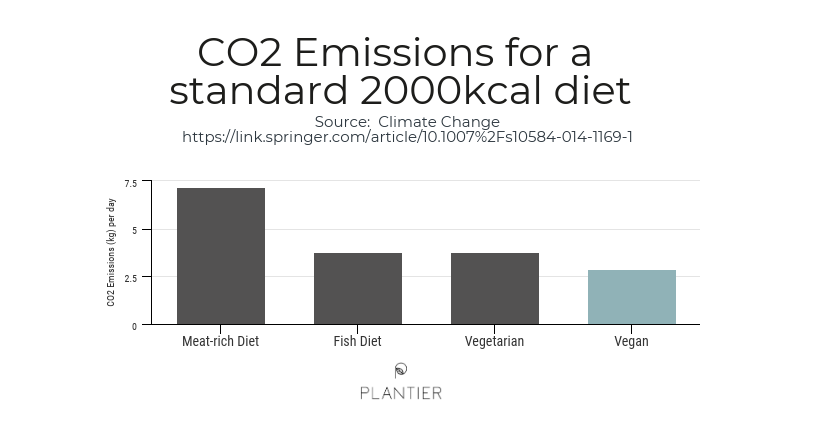Plant-based and the Environment
By Vivienne and Poornima, Co-Founders of Plantier
Evolution of the human diet
Up until now, the focus on meatless diets has focused on cruelty to animals, and whilst this is still a major talking point, recently there has been a lot more discussion centering around the environmental impact of food production.
You may be wondering why this is all of a sudden such a hot topic when humans have consumed meat for several million years. Over a relatively short period of time, our global consumption of meat has increased significantly to almost double that of 50 years ago. This meat and dairy heavy diet, adopted by the developing world, has seen the average amount of meat consumed per person increase from 23kg in 1961 to 43kg in 2014. With the population projected to grow by a further two billion people by 2050, the global meat consumption is only set to rise unless there is a global food revolution.
What’s the link?
Though, you might be wondering how much of a difference being flexitarian (occasionally eating meat) or adopting a plant-based diet would actually have on climate change and asking yourself: How can what I eat impact the environment positively? Well, as it turns out, recent studies show that our food consumption habits and demands do in fact have pretty hefty impacts on the environment. There are three main ways that animal agriculture negatively affects the environment - 1. greenhouse gas emissions, 2. water consumption, and 3. land usage and pollution.
The Greenhouse Gas Emissions of Food Production
A research study published in Science shows that while meat and dairy provide just 18% of calories and 37% of protein, they use the vast majority, in fact 83%, of farmland and produce 58% of agriculture’s greenhouse gas emissions.
According to the acclaimed documentary Cowspiracy, animal agriculture is responsible for between 18% to about 50% of worldwide greenhouse gas emissions, which is more than the combined emissions of transportation which ranks at 13%. The methane that is produced by animal livestock is 25-100 times more destructive than carbon dioxide is over a 20 year period. In fact, the greenhouse gas emissions from producing 100g of beef or pig meat is significantly greater that the emissions from producing 100g of plant-based proteins like beans, tofu or peas.
So how do the diets compare? A study, conducted by the University of Oxford, analyzing the diets of 30,000 meat eaters, 16,000 vegetarians, 8,000 fish eaters and 2,000 vegans, found that meat-rich diets resulted in 7.2kg of carbon dioxide emissions while both fish-eating and vegetarian diets producing about 3.8kg of CO2 per day, and vegan diets produced only 2.9kg.
2. The Underestimated Water Consumption of Food Production
A 2010 study shows that the fresh water footprint or “thirst levels” of vegetables and fruits was significantly less than that of dairy and meat. To put this into perspective, Cowspiracy estimates that the fresh water needed to produce the meat in one hamburger is equivalent to an average human being have a shower for 2 whole months, with the meat and dairy industries using about a third of the world’s fresh water usage. So whilst we’ve all been diligently turning the tap off when we brush our teeth, having shorter showers and using the low-flush button on the toilet, popping to our local burger restaurant is having a far greater impact on our water consumption. Friends of the Earth estimate that adopting a vegetarian diet (so still consuming some dairy products) could decrease your water-related footprint by 36%.
3. The Land-usage & Pollution of Food Production
The Land-Intensivity of our Diets
Livestock agriculture takes up 80% of global land use producing less than 20% of the world’s supply of calories. According to the U.N. Convention to Combat Desertification, it takes up to 10 pounds of grain to produce just 1 pound of meat, and in the United States alone, 56 million acres of land are used to grow feed for animals, while only 4 million acres are used to produce plants for humans to eat. Doesn’t this feel back to front when there are still millions of children dying of malnutrition every year?
The land needed to produce the growing global need for animal products has resulted in grave consequences for our forests with Cowspiracy indicating that 1-2 acres of rainforest land are being cleared every second, and animal agriculture being responsible for 91% of the destruction of the amazon rainforests.
Dead Zones in Water Systems
What’s happening in our water systems? The nutrient pollutants, usually Nitrogen and Phosphorous, resulting from animal agriculture and crop production reach the water through surface runoffs of soil and fertilizers, discharges from feedlots and greenhouse gas emissions that make their way into water bodies during rainfall. These pollutants are stimulating the growth of phytoplankton or algae in coastal environments, which when they die sink to the bottom and are decomposed. This decomposition consumes the oxygen in these deep waters to create what are known as dead zones, or low-oxygen zones, causing marine life to die or migrate to other areas. The impact of this nutrient water pollution is thought to be more devastating than the BP oil spill in 2010. According to a report by The Guardian, the coastal dead zones have increased tenfold, while ocean dead zones have quadrupled since 1950.
For more information about the impact of our food consumption on the environment, visit Cowspiracy’s fact sheet.
There’s still time
This is a wake-up call for us all and there is no denying the impact our food preferences are having on our planet. The good news is that we still have time to rectify this and prepare for our growing population. This is a great opportunity for us to live and eat like previous generations, armed with the knowledge that our actions are quite literally saving the planet! With so many inspirational chefs, books and blogs, plant-based meals are now so filling and full of flavour and texture, it makes it so easy to cut down on meat.
Help us spread this message! If you have experienced an uninspiring plant-based option (or even worse, no option at all!) on a menu, let us know and we’ll do all we can to inspire the restaurant. Please get in touch.






